| |
|
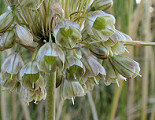 | |
| MaltaWildPlants.com by Stephen Mifsud |

|
| |
|
|
 |  |  |  |
| External Links: |
|
Erigeron bonariensis (Flax-Leaved Fleabane) |
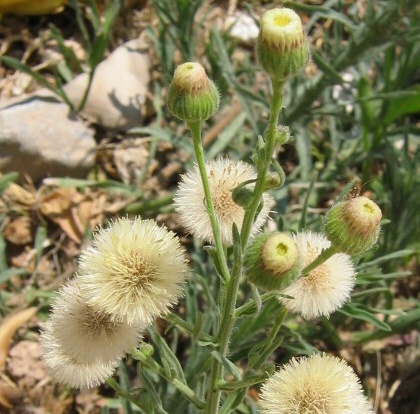
Erigeron bonariensis (ASTERACEAE.)
Images for this profile are taken from the Maltese Islands after year 2000. |
|
| Nomenclature |
Species name : | Erigeron bonariensis L. | Authority : | Carl von Linne, Sweden, (1707 - 1778) | Synonyms :
(basionym or principal syn.) |
Leptilon bonariense
Small
Synonym that was used for long in Malta:
Conyza bonariensis
(L.) Cronquist
Full list of synonyms :
[Euro+Med]
[PlantList]
[IPNI]
[POWO]
[Catalogue of Life]
[Worldplants.de]
|
Plant Family : | Asteraceae Bercht. & J.Presl (= Compositae )
(Daisy or Sunflower Family) | English name(s) : | Flax-Leaved Fleabane, Hairy Fleabane, Asthmaweed | Maltese name(s) : | Żagħżigħa selvaġġa | Status for Malta : | Naturalised Alien. Species that was introduced in Malta after year 1492 (Columbus' discovery of the New World)
and spreads and integrates to form established, non-invasive populations.
Species may become become invasive if it widespreads rapidly. | Name Derivation : | | Remarks : | |
|
| Morphology and structure |
PLANT STRUCTURE: |
Character | Growth Form | Branching | Surface |
Description | | | |
General
Picture |  |  | 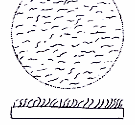 |
|
LEAVES: |
Character | Arrangement | Attachment | Venation |
Description | | | |
General
Picture |  |  |  |
| |
Character | Leaf Shape | Leaf Margin | Remarks |
Description | | | |
General
Picture |  |  |  |
|
FLOWERS: |
Character | Colour | Basic Flower Type | No. of Petals | No. of Sepals |
Description | Green Referring to the rayless flower head. | | 0 Petals or ray-florets are absent. | around 50 Referring to the phyllaries of the involucre. |
General
Picture | |  |  |  |
| |
Character | Inflorescence | Description | Ovary | Stamens |
Description | | Cup shaped flower heads, mainly formed by the green round-shaped involucre. The top side of the 'cup' consists of a brush border of white pappii, and a yellow centre consisting of several disc florets. Ray florets are absent. | | |
General
Picture |  |  |  | 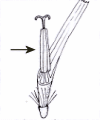 |
| |
Character | Scent | Average Flower Size | Pollen Colour | Other Notes |
Description | None | 5-7mm | Yellow | - |
|
SEEDS: |
Character | No. Per Fruit | Shape | Size | Colour |
Description | 100-200 Seeds closely packed on a common receptacle. | | 2mm (excluding pappus). | Seed is light brown , pappus is whitish-beige / straw colour |
General
Picture |  |  |  |  |
|
FRUIT AND OTHER BOTANICAL DATA: |
Character | Fruit Type | Colour of Fruit | Subterranean Parts | Other Notes |
Description | | Light Brown | | Fruit-head It is a beige, spherical and slightly flatten structure (cushion-shaped) made up of the soft pappii of the achenes. Seed head measures 10-14mm across. |
General
Picture | 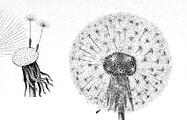 |  |  |  |
|
|
| Plant description and characters | |
Life Cycle: | Annual. |
Growth Form: | THEROPHYTE (annual plants, herbaceous) |
Habitat: | Mostly in urban and semi-rural areas such as roadsides, cracks in the pavement, curbs of flagstones, parks and old gardens, waste ground, dumping sites, stone piles, rubble walls, abandoned fields, farms and field margins |
Frequency: | Common |
Localities in Malta: | Almost found everywhere, especially along roadsides, pavements and waste land. |
Plant Height: | 30-100cm. |
| Apr-Nov |
Protection in Malta: | Not legally protected till the last update of this website (2/Mar/2022) |
Red List 1989: | Not listed in the Red Data Book of the Maltese Islands |
Poison: | |
This plant have long stems which, sometimes forms branching at its base and rarely exceeds more than 4 stem branches. Flowering stems are sometimes branches higher up the stem. Stems, young leaves and flowering parts has some short, fine, white hairs. The stem is hardly visible, since it is hidden by the numerous appressed leaves.
The leaves grow in groups , typically 3-6 leaves each, from common loci, alternately along the stem at an acute angle to the stem. The length of the leaves from each group is varied, usually a long one with the rest much shorter. The lower basal leaves are linear/lanceolate with few alternate dentations (teeth like projections), while the leaves of most of the stem are simply linear with a smooth outline. Their colour is greyish-green.
Flowers are produced only at the top of the stem and are produced as dense, cone shaped panicles. The flowers are mostly green, since the enclosing cup-shaped involucre makes a large part of the flower. The involucre is made up of numerous, thin, overlapping structures called phyllaries which often have an interesting tapering, purple/wine tip.
The flower head lacks petals, (ray florets) and it consists of central yellow disc florets, surrounded by a ring of bristly off-white pappii packed closely together by the green involucre and resting on a common receptacle. The pappii are higher from the disc florets. The disc-florets of this species are further modified to form what they are called filiform florets. They are very similar to disc florets in structure, but They consist of pistils without fused stamens.
As the fruit develop, so does the pappii which gets more loose, open up and form a cushion-like feathery structure (12mm x 8mm circa), which is more conspicuous from the flower itself! The colour is stramineous (straw colour) to light brown. The seeds are tiny, simple achenes with an unbranched filamentous pappus. With wind the seeds leaves the plant and disperses away. Each flower head may produce between 125-180 seeds.
|
|
| Information, uses and other details |
Nativity and distribution
This plant is native to South America. The species name "bonariensis" suggests specifically that it is from Bon Aries - capital of Argentina. the plant was described by A. Cronquist. it is now distributed around all the world (except Antarctica). [289]
Medicinal properties
A table of the medicinal properties of Hypericin and other main constituents of the plant are tabled below [ 271, WWW-06, WWW-28]
| Astringent |
Produces contraction in the soft organic tissues, and so discharges of blood, mucus, etc.
[WWW-32 ] |
| Diuretic |
Tending to increase the secretion and discharge of urine. [WWW-32] |
| Pungent: |
has a sharp biting or acrid taste. [ WWW-32] |
| Tonic |
a medicine that strengthens and invigorates hence restore normal tone to tissues or to stimulate the appetite. [WWW-32] |
It is claimed to be efficient in diarrhoea, gravel, diabetes, scalding urine and hemorrhage of the bowels, uterus and of wounds. Several writers indicate that the extracted oil is similar to oil of turpentine, but less irritating. It is recommended for pimples and long time ago it was said that if
"bound to the forehead it is a great help to cure one of the frensie." [WWW-28]
Finally, it was found that in Tanzania this plant have a raw use for babies who hesitates to suckle milk from their mother. Quoting text:
"for a baby who does not want to suckle, the plant is crushed and applied on the nipples, which will cause to baby to suckle" [291]
Antimicrobial + Antifungal activity
Pharmacy honours students ( Nyanyiwa, M. and Gundidza, M. ) demonstrated how oils extracted from Conyza bonariensis amongst other plants had antimicrobial effects. They extracted essential oils from leaves of the plants Ageratum conzyoides, Plectranthus ecklonii Benth, Conyza scabrida and Conyza bonariensis and tested them for antibacterial and. anti-fungal activity using the agar diffusion method. The results showed that the essential oils of the four plants had antibacterial and antifungal activity. Of all the oils Plectranthus ecklonii had the highest zone of inhibition for Pseudomonas aeruginosa, and Conyza scabrida had the highest percentage inhibition against Candida albicans. Plectranthus ecklonii Benth had the highest percentage inhibition on Aspergillus niger. They concluded that the oils can be considered in the formulation of dermatological formulation to treat skin infections. [288]
Similarly, Bashir Ahmad Chaudhry et al. at Bahauddin Zakariya University, Pakistan performed biological studies on Conyza and Euphorbia species. They extracted oil from the plants by solvents petroleum ether and dichloromethane. They showed how C. bonariensis had antibacterial activity (ay 10mg/ml) and Cholinergic activity when its oil was extracted with dichloromethane. It showed Brine shrimp toxicity ( toxicity to larvae of brine shrimps) when the oil was extracted by petroleum ether. They reported no antifungal activity to Cladosporium cucumerinum. [292] / [See link in reference list below]
Dermititis
There are a number of reports that indicate the cause of dermititis by Conyza bonariensis among other Conyza species and some species of other Asteraceae genii. A skin allergy (referred to as Australian bush dermitits) seems to be caused by 'dusts' formed by the breakdown of senescent tissues of such species. Also allergic contact dermititis was demonstrated to be possible from fleabane flowers, leaves and stems. [WWW-27]
Resistance to Herbicides
This plant is notorious for its herbicide resistance characteristic. There are several reports about this fact. For example in Egypt this weed first evolved resistance to Group D/22 herbicides in 1989. Group D/22 herbicides are known as Bipyridiliums (Photosystem-I-electron diversion). Research has shown that these particular biotypes are resistant to paraquat and they may be cross-resistant to other Group D/22 herbicides. [WWW-29]
Below is a citation from the abstract taken from the research done by Amsellem et. al regards Developmental variability of photooxidative stress tolerance in paraquat-resistant Conyza. [290]
Paraquat resistance in C.bonariensis has been extensively studied, with some contention. A single, dominant gene pleiotropically controls levels of oxidant-detoxifying enzymes and tolerance to many photo oxidants, to photo inhibition, and possibly to other stresses. The weed forms a rosette on humid short days and flowers in dry long days and, thus, needs plasticity to photo oxidant stresses.
In a series of four experiments over 20 months, the resistant and susceptible biotypes were cultured in constant 10-h low-light short days at 25 degrees C. Resistance was measured as recovery from paraquat. The concentration required to achieve 50% inhibition of the resistant biotype was about 30 times that of the susceptible one just after germination. Resistance increased to > 300 times that of the susceptible at 10 weeks of growth, and then decreased to 20-fold, remaining constant except for a brief increase while bolting. Resistance increased when plants were induced to flower by long days.
The levels of plastid superoxide dismutase and of glutathione reductase were generally highest in resistant plants compared to those of the susceptible at the times of highest paraquat resistance, but they were imperceptibly different from the susceptible type at the times of lower paraquat resistance. Photo inhibition tolerance measured as quantum yield of oxygen evolution at ambient temperatures was highest when the relative amounts of enzymes were highest in the resistant biotype. Resistance to photo inhibition was not detected by chlorophyll a fluorescence.
Enzyme levels, photo inhibition tolerance, and paraquat resistance all increased during flowering in both biotypes. Imperceptibly small increases in enzyme levels would be needed for 20-fold resistance, based on the moderate enzyme increases correlated with 300-fold resistance. Thus, it is feasible that either these enzymes play a role in the first line of defense against photo oxidants, or another, yet unknown mechanism(s) facilitate(s) the lower level of resistance, or the enzymes and unknown mechanisms act together " [290]
According to a Weed Susceptibility Chart compiled by Harry Agamalian et al (see references below) the herbicide commonly known as DIFENZOQUAT (AVENGE) is excellent to treat C.bonariensis
More detailed information can be read about herbicide resistance from the Further Information and Links of this section
Personal Observations
C. bonariensis has a very developed root system. It was impossible to pull the plant out from the ground. To obtain a specimen, a sharp pen-knife had to be used. Probably this fact plays part in the survival of this plant during the long and hot Summer season [SM]
This plant is very well adapted to grow in rocky or stony grounds. It is often seen growing from cracks in roads and pavements, or at the lining between the pavement and the road. It is amazing how from little soil and water this plant can resist Summers. [SM]
It is also notorious for Maltese herb control workers around the streets. according to a personal communication with one of the workers once in May, while he was cutting wild grass and plants from the roads and spraying some herbicide upon the pavement. It came out that they were spraying a herbicide to control this weed (i.e. flax-leaved fleabane). He admitted that so far they could not control this plant. What he added, then, was quite worrying - "don't let dogs sniff around here because the herbicide we are using is harmful !".... One wouldsurely prefer some fleabanes around and have his/her dog healthy! [SM]
I do not know if there is any connection between this plant and fleas. The genus name conyza is derived from the Greek word - flea, and the English names also suggests fleas. Personally I think that this particular species has nothing to do with fleas. Any comments or info on this please send them in (info@maltawildplants.com) [SM]
|
|
| Links & Further literature
(0 papers) |

Google Web |

Google Images |

Google Scholar |

Research Gate |

Wikipedia |

JSTOR |

GBIF |

Med Checklist |

Cat. of Life |

EoL |

IPNI |

World Flora Online |

Plants of the World Online |

Vienna Virt. Herb. |

RBGE Herbarium |

KEW Herbarium |

MNHN |

Arkive |

IUCN |

CABI |
Kindly Email if there are papers and publications about local
studies or information about this species to be included in the list above.
|
| Photo Gallery (35 Images) |  |
 |
 |
 |
IMAGE: EGRBO-01 Photo of the composite, cylindrical shaped, rayless flowers. |
IMAGE: EGRBO-02 Photo of rayless composite flowers and ball of pappus-bearing seeds. |
IMAGE: EGRBO-03 Close up photo of a cluster of rayless flowers and apical barrel-shaped buds. |
IMAGE: EGRBO-04 Photo of a panicle consisting of many stalked upright flowers. |
 |
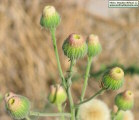 |
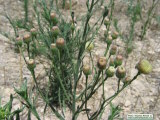 |
 |
IMAGE: EGRBO-05 Close up photo of a rayless flower. Stout, cylindrical shaped flower with the top consisting of peripheral white brush border and central yellow disc-florets. The tip of the numerous slender phyllaries is red. |
IMAGE: EGRBO-06 Close up photo of several flowers. There is some degree of variation between flowers. This flower has an 'enhanced' brush border of pappus (not flat-topped) and is tinged in rose-pink. The flower form is more curved rather than cylindrical shape. |
IMAGE: EGRBO-07 Species with more flattened flower forms and pink-reddish tinged pappii. |
IMAGE: EGRBO-08 Close up photo of flower from the plant of the previous photo on the left. |
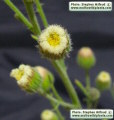 |
 |
 |
 |
IMAGE: EGRBO-09 Close up photo of flower (top view). At the right-middle part of the flower you can note an open, star-shaped, yellow disc floret, which measures only about 1 mm in diameter. |
IMAGE: EGRBO-10 Scanned image of upper part of plant showing rayless flowers in panicle inflorescences and some young leaves. |
IMAGE: EGRBO-11 Scanned image against a dark background of flowers. Note how the involucre is formed by numerous red tipped phyllaries. |
IMAGE: EGRBO-12 Magnified scanned image of flower. Note the short hair covering flower stem, phyllaries and hence the whole involucre. |
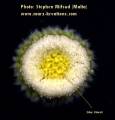 |
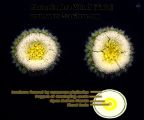 |
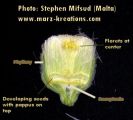 |
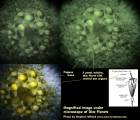 |
IMAGE: EGRBO-13 Close up photo of flower head showing central disc florets. |
IMAGE: EGRBO-14 Close up photo of flower head with detail annotations. |
IMAGE: EGRBO-15 Scanned and annotated image of a longitudinal dissection of a flower head. |
IMAGE: EGRBO-16 Magnified images under light microscopic of disc florets and bristles of the pappii. |
 |
 |
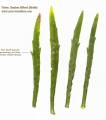 |
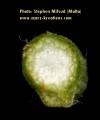 |
IMAGE: EGRBO-17 Stem showing its plenty, long, linear shaped leaves. They grow as a group of 3-6 leaves from the same locus at alternate positions along stem. |
IMAGE: EGRBO-18 Leaves at apex of stem shoot, covered with fine white short hair. |
IMAGE: EGRBO-19 Lower leaves : linear shape with a smooth outline but with occasional alternate small lobes projecting out. |
IMAGE: EGRBO-20 Cross section of stem. |
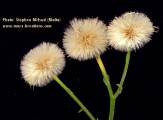 |
 |
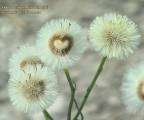 |
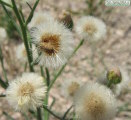 |
IMAGE: EGRBO-21 Scanned image of fruit. It is made up of many small seeds which bear a bristly pappus on top that serves as a means for seed dispersion by wind. |
IMAGE: EGRBO-22 Scanned image of fruit. The pappus is a characteristic feature of a number of Asteraceae genii. The seed+pappus head of this species is relatively small, about 10-13mm in diameter. |
IMAGE: EGRBO-23 Photo of seed-head with some seeds already dispersed and hence showing the radial arrangement of seeds on the receptacle. |
IMAGE: EGRBO-24 Photo of fruit with mature seeds of which some have already been disperesed away by wind. The small seeds are light brown and very thin. |
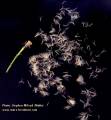 |
 |
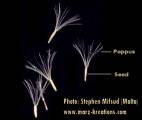 |
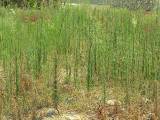 |
IMAGE: EGRBO-25 Scanned image of seeds, about 180 per fruit. |
IMAGE: EGRBO-26 Magnified scanned image of seeds against a dark background. Bristles of pappus are unbranched. |
IMAGE: EGRBO-27 Highly Magnified scanned image of seeds, which consists of a tiny linear sead and a beakless, funnel shaped pappus. |
IMAGE: EGRBO-28 Plants in their natural habitat, here in an uncropped field in Summer. (Taken on 10th August 2003). |
 |
 |
 |
 |
IMAGE: EGRBO-29 Photo of upper part of plant consisting of rayless, cylindrical flowers and fruit made up of a cushion like head of pappus. |
IMAGE: EGRBO-30 Photo of plant in dry fields (Jul 2004). |
IMAGE: EGRBO-31 Photo of plant in their most common habitat, that is beside walls (Jul 2004). |
IMAGE: EGRBO-32 Photo of plant beside limestone walls (Jul 2004). |
 |
 |
| | IMAGE: EGRBO-33 Photo of a young plant in an uncropped filed near Mriehel Industrial Estate (Oct 2004). |
IMAGE: EGRBO-34 |
IMAGE: EGRBO-35 |
IMAGE: EGRBO-36 |
|
| | |

